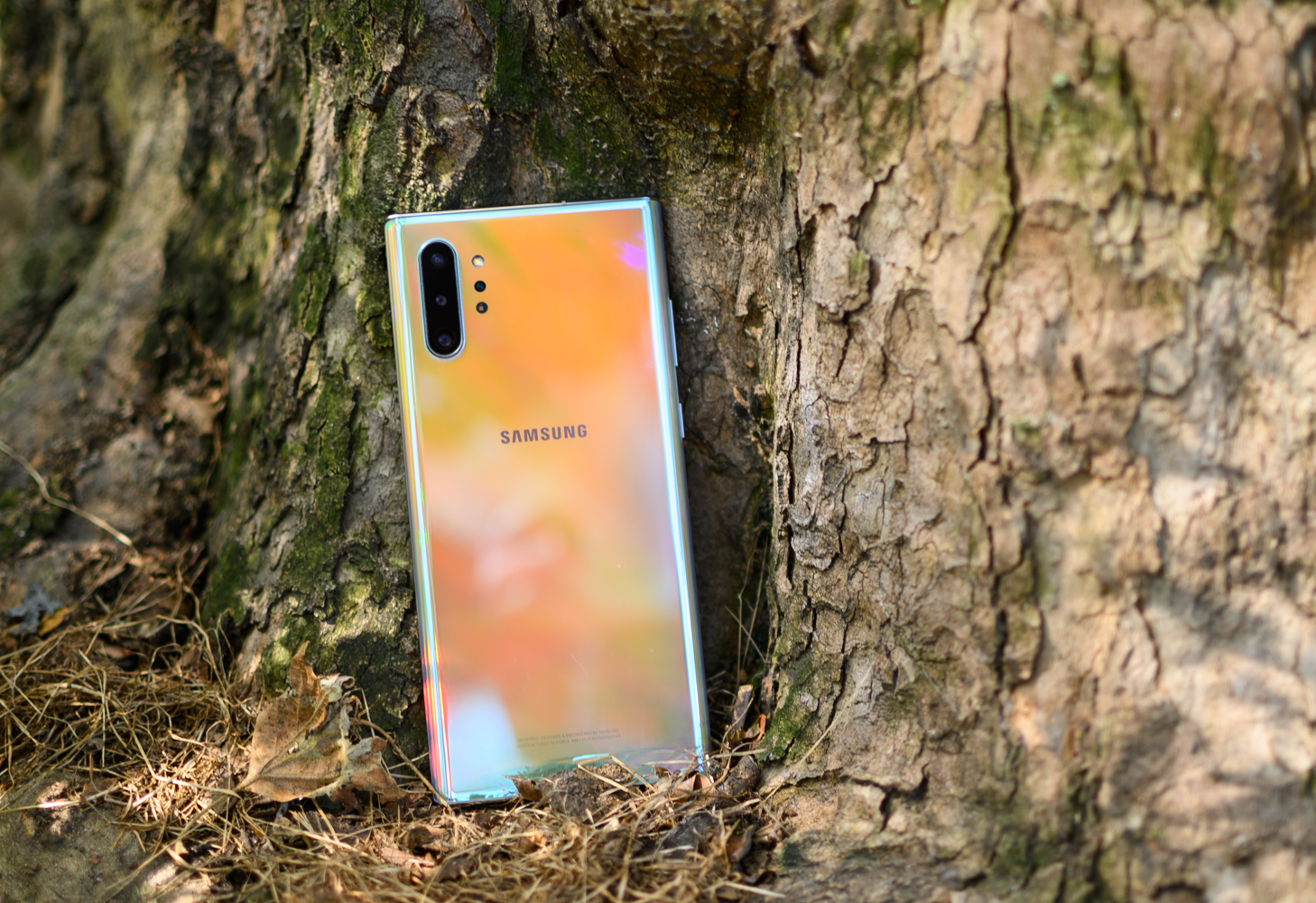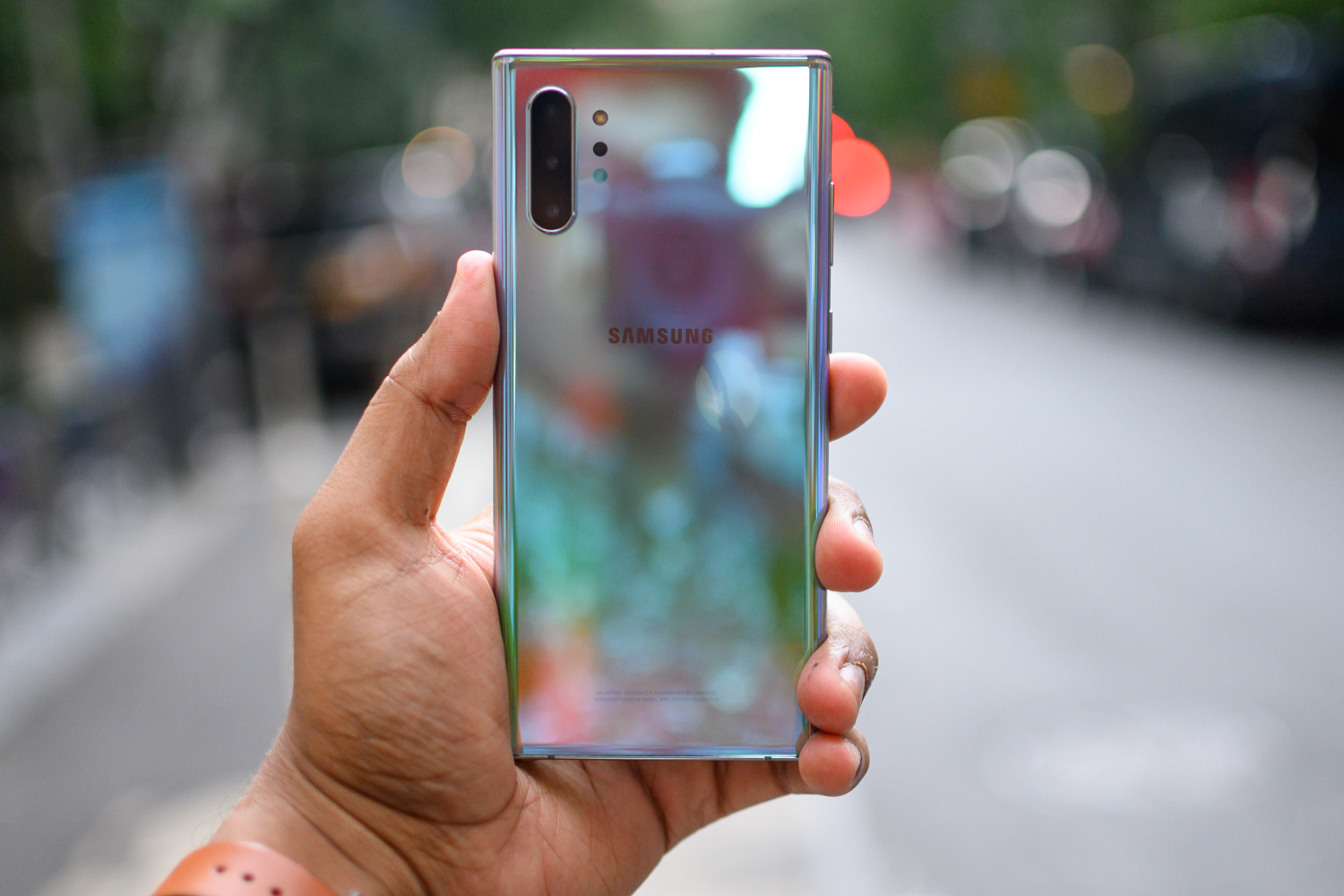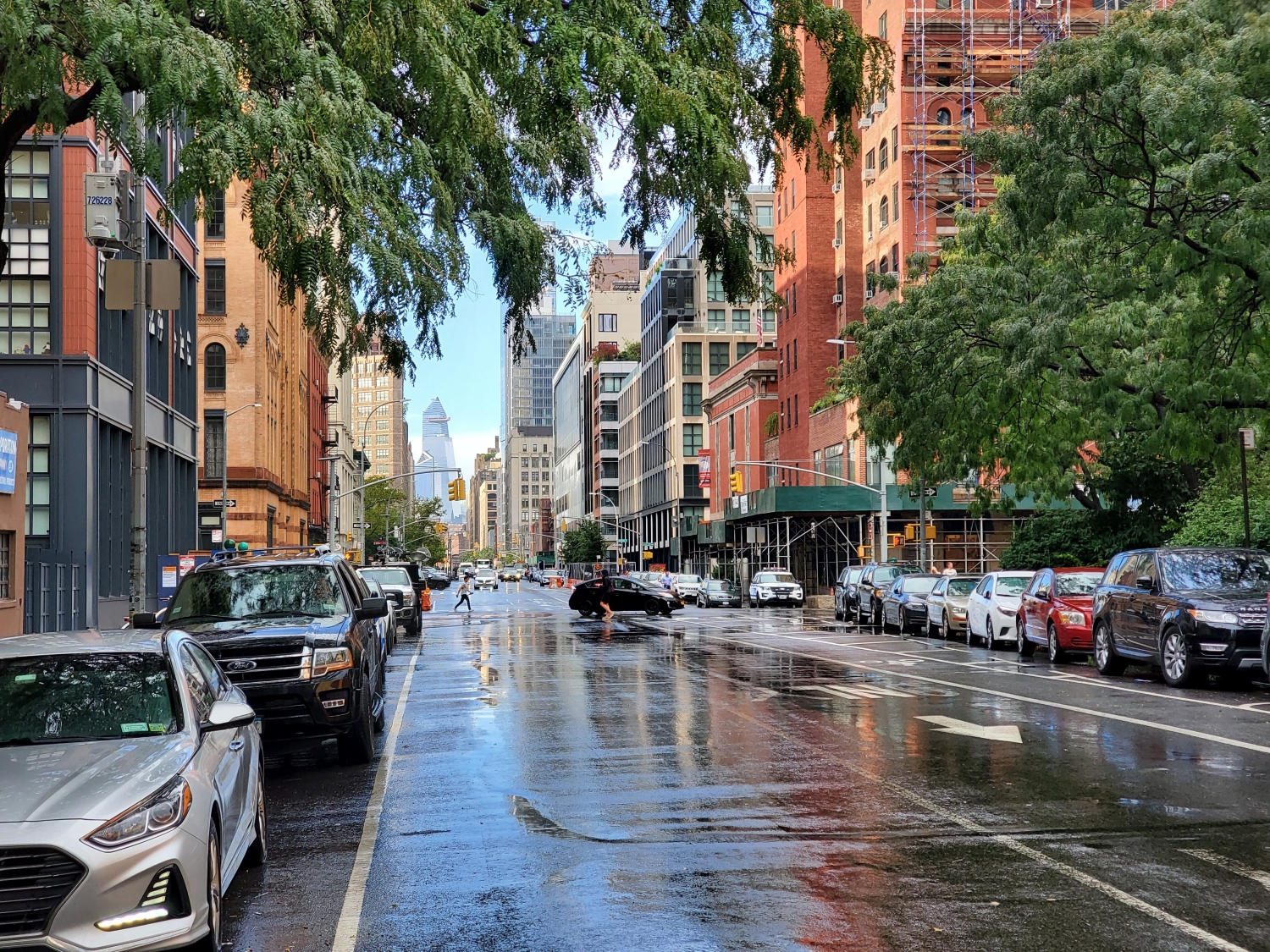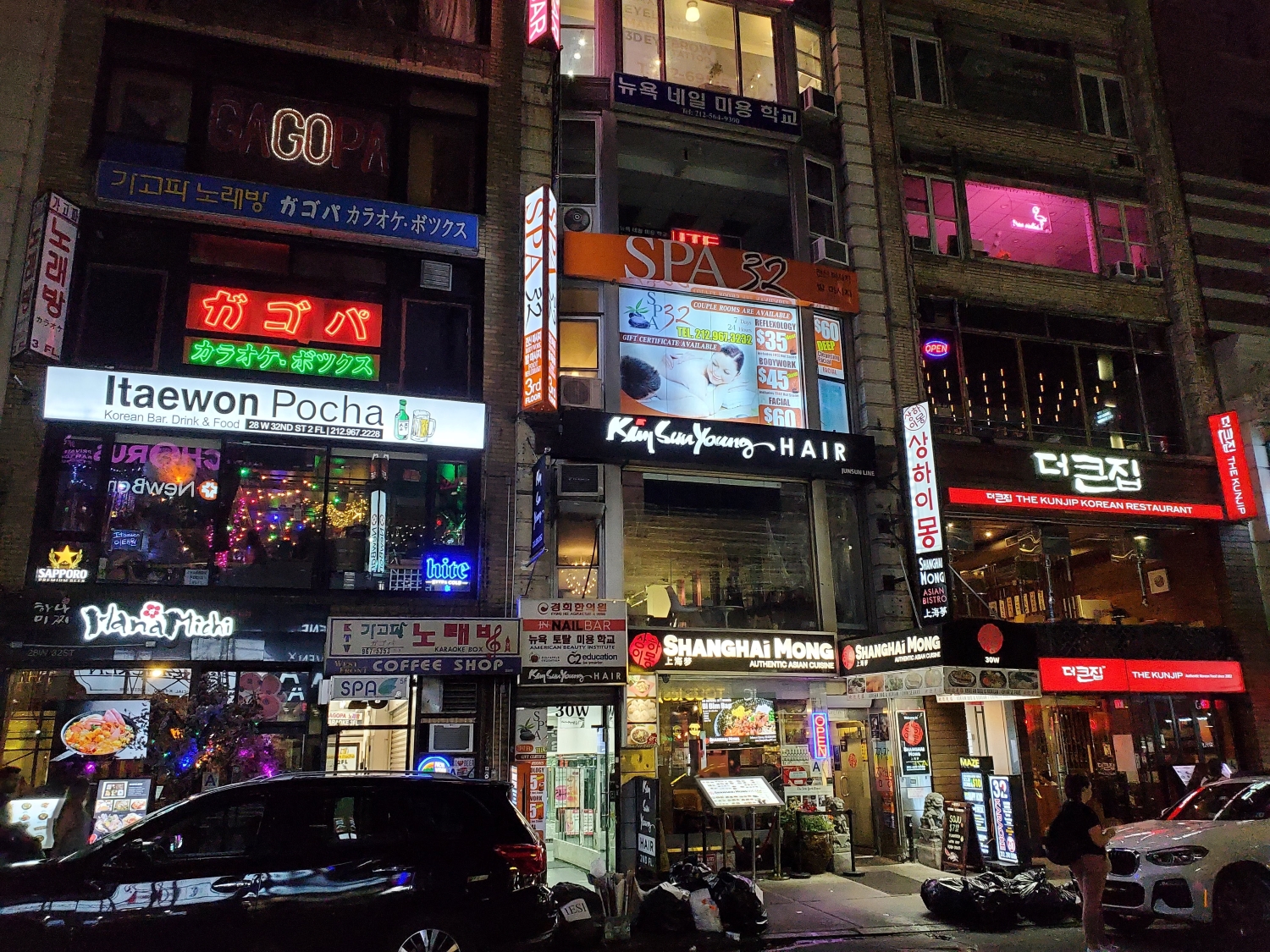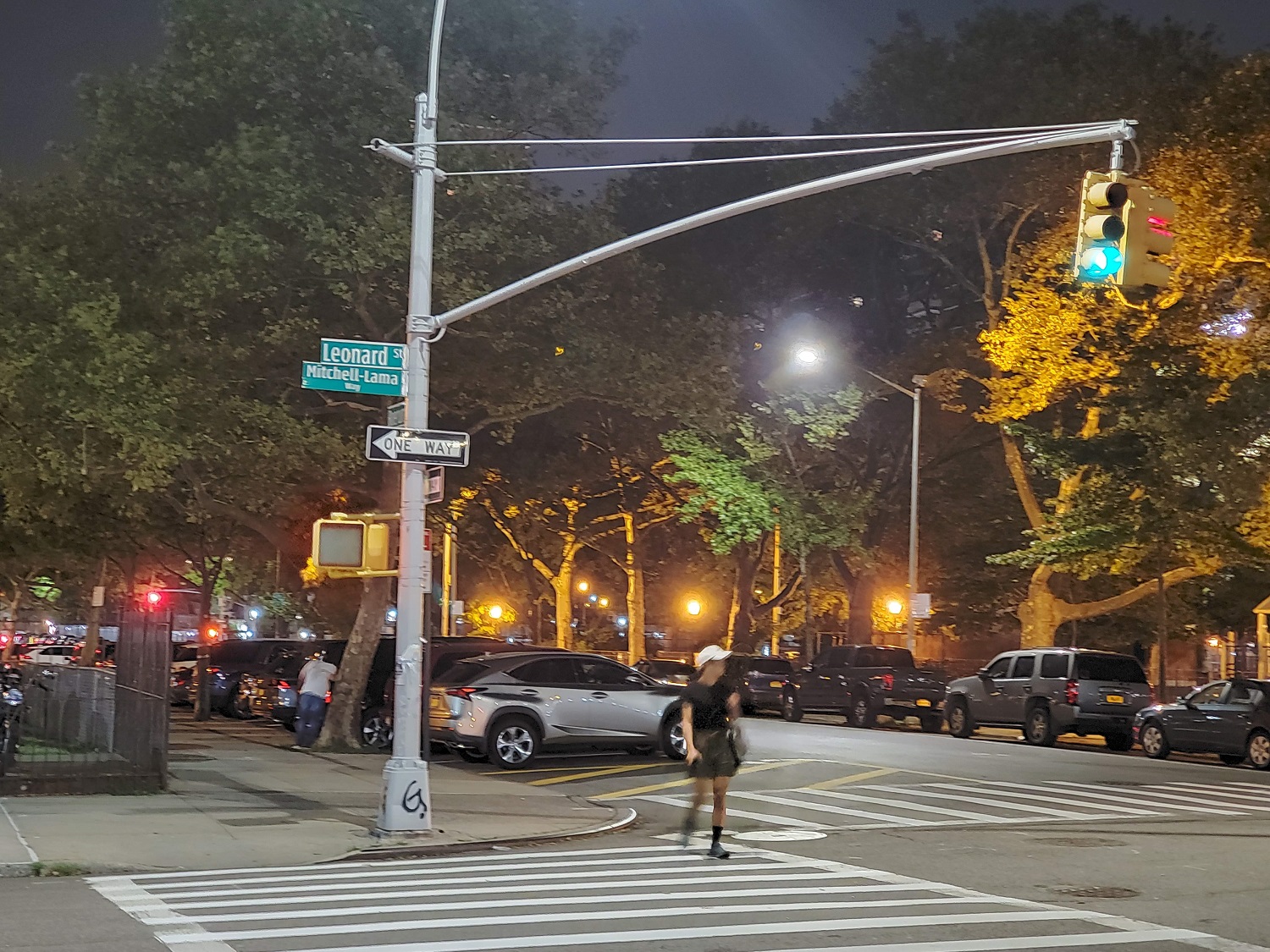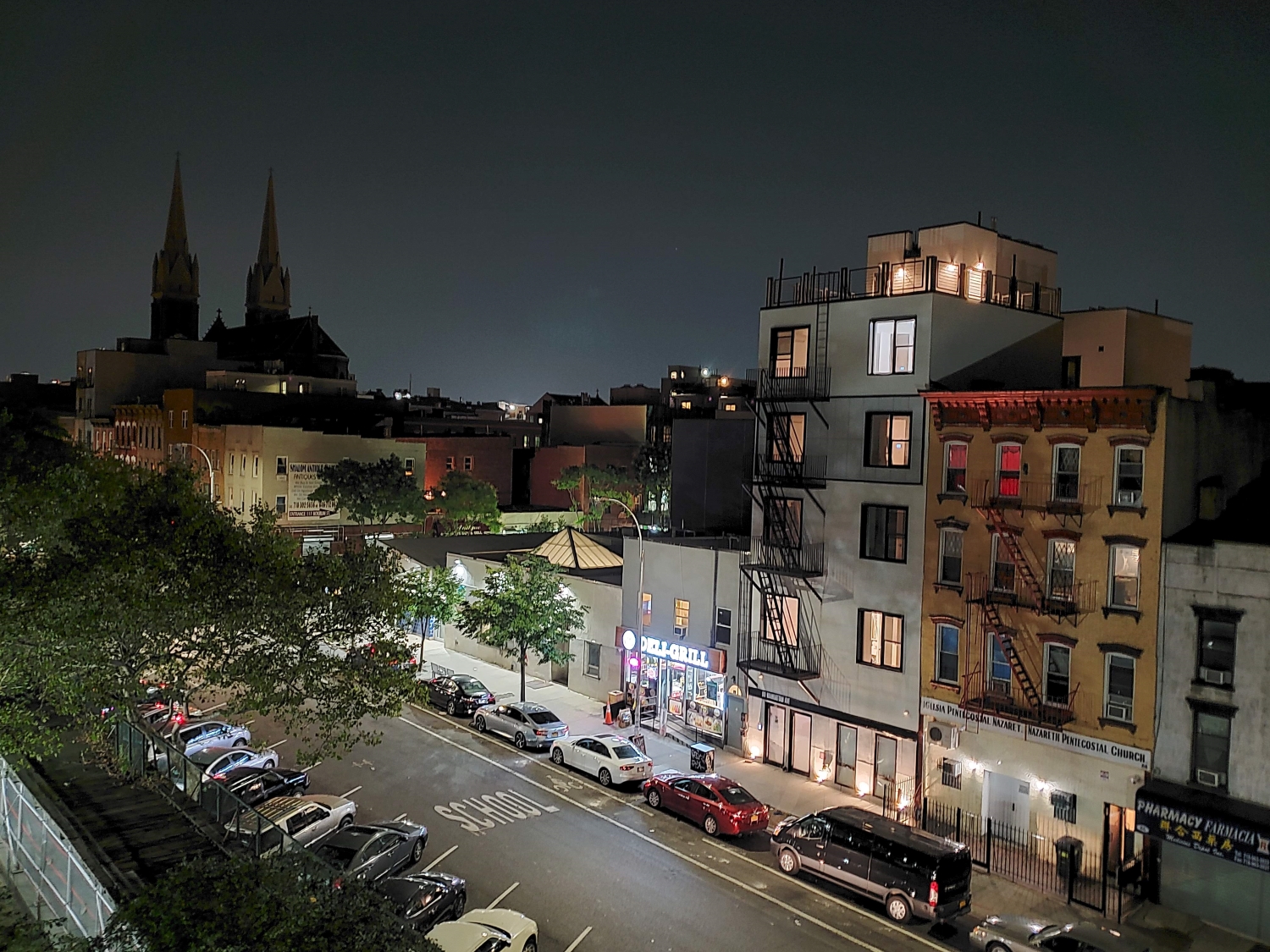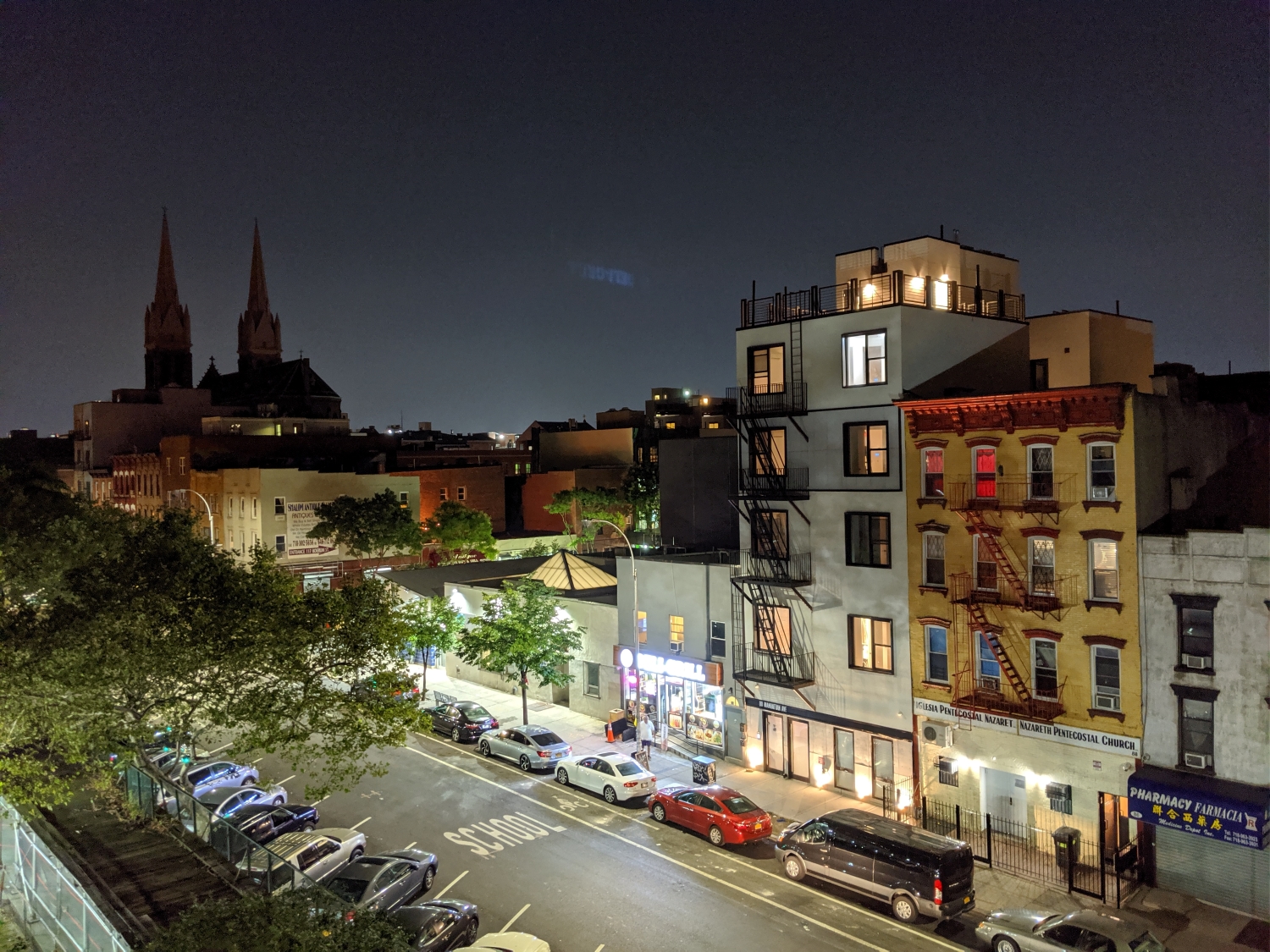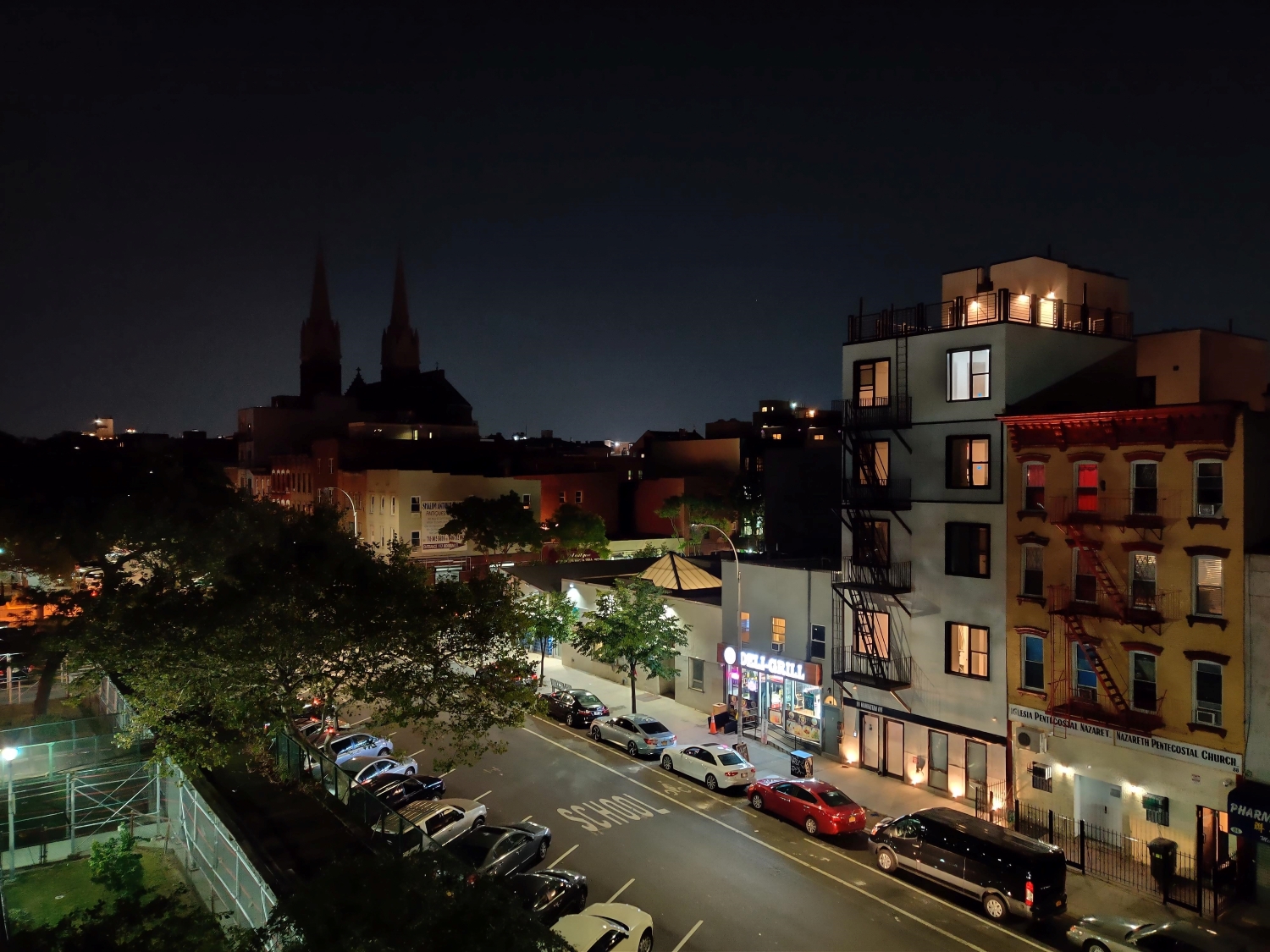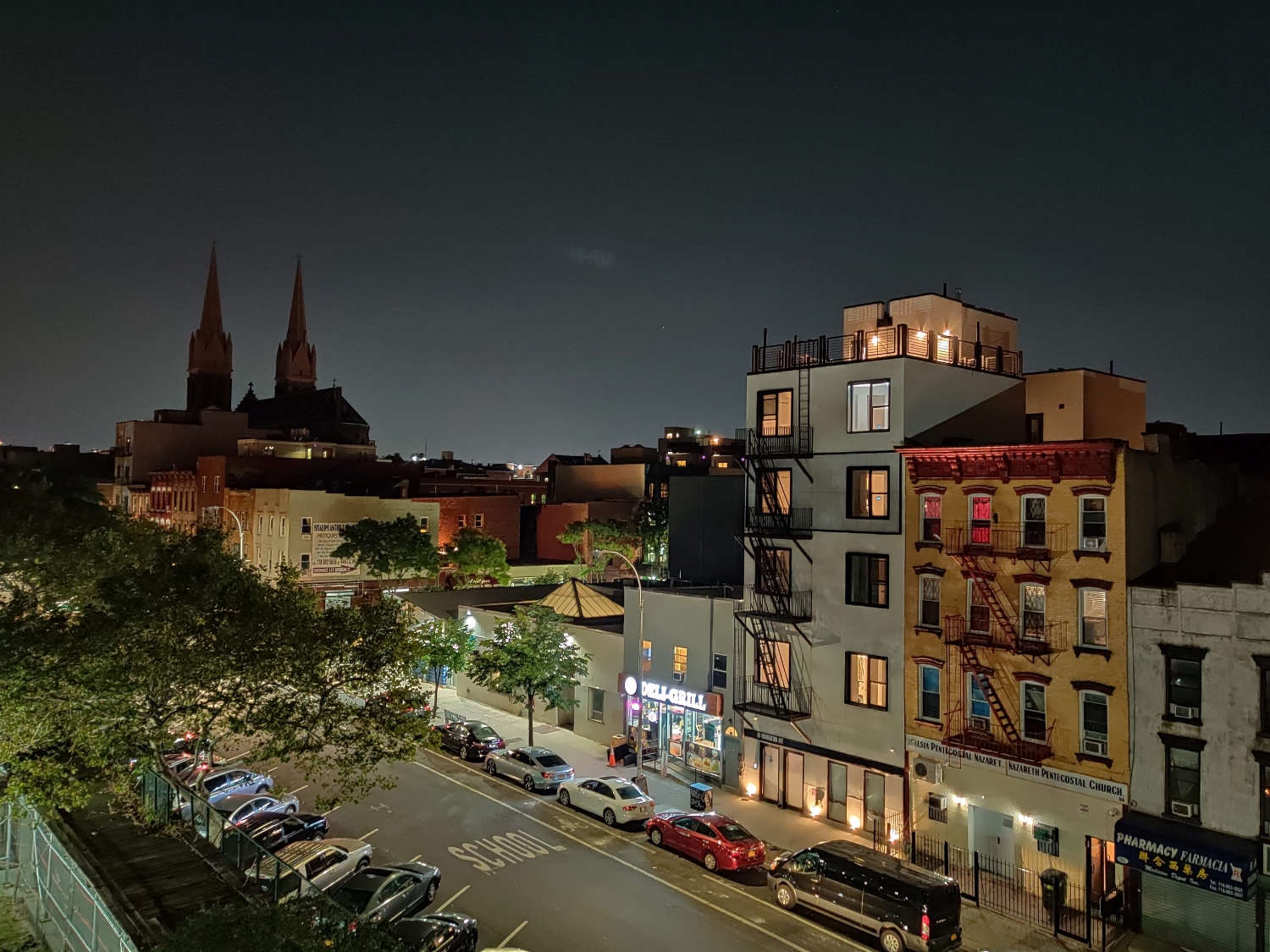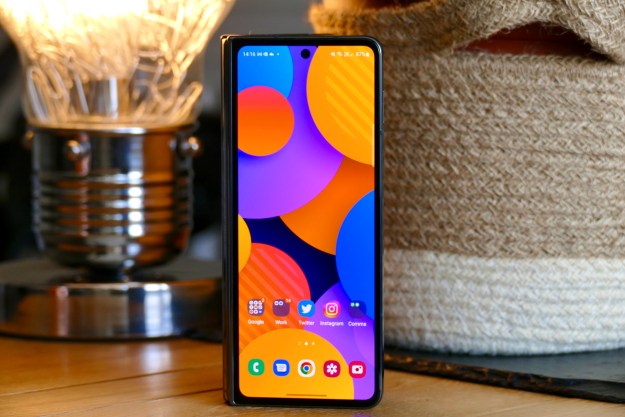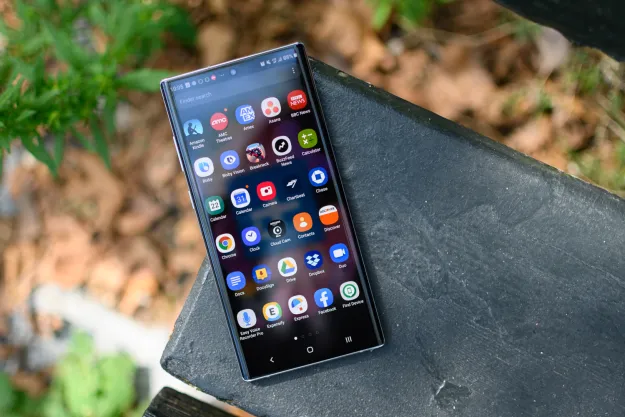
- Gorgeous Aura Glow color, fantastic screen
- Versatile and strong camera suite
- Super-fast charging speed
- Helpful Windows integrations
- Speedy performance, UFS 3.0 support
- Battery life could be better
- Many unnecessary, gimmicky features
The Samsung Galaxy Note 10 Plus takes everything great about the Galaxy S10 Plus and raises the bar a little further. To get to that greatness, you’ll need to get past gimmicky features, but the phone core is solid.
This is the phone to buy and hold onto for more than two years easily making it one of the best Android phones out now. If you’re looking for the all-encompassing phone that can do it all, and do it all well, you can’t do better than the Note 10 Plus.
Behold!
The Galaxy Note 10 Plus is all about style. Around front, you’re treated to a vast 6.8-inch screen, which is surrounded by some of the thinnest bezels I’ve seen to date. There’s a hole-punch camera again, but unlike those on the Galaxy S10 phones, it’s small and centered. You’ll still see it, but it doesn’t take up much space on the status bar.
While the screen is gorgeous — more on it soon — the back is arguably more interesting if you buy the Aura Glow color. It’s an exhilarating mix of iridescence and chrome, and the result is fabulous. It’s eye-catching, magical, and an undeniable showstopper. The phone also comes in Aura Black, Aura White, and Aura Blue (the latter is exclusive to the U.S.), but Aura Glow is the one you’ll want.

It’s impossible to deny the Note 10 Plus’ resemblance to the Huawei P30 Pro or the iPhone XS. The Note is angular, but the vertical camera layout is what makes it easy to draw comparisons. It’s impossible for me to pick one out as the most beautiful, but that’s a testament itself to how good the Note 10 Plus looks. It truly is the best-looking Galaxy Note phone ever.
It’s a shame that attractive rear design draws fingerprints so easily. I found myself wiping it down often so the smudges wouldn’t ruin the look. A clear case might be the best option if you want protection, but don’t want to hide the design.
I’ve seen some complaints about the rear scratching quickly and can confirm that you’ll need to handle this phone like a great piece of art if no harm is to come to it. I haven’t dropped it or put it in a pocket full of keys, yet there is one small scratch on the Gorilla Glass 6 on the back. The highly-reflective design makes it obvious, unfortunately. It’s even more reason to snap a clear case on this phone as soon as you get it.
Aura Glow is an exhilarating mix of iridescence and chrome.
The Note 10 Plus is a behemoth of a phone. It feels massive even in my large hands, and while I have to shift the phone a little to reach the top, I can still comfortably use it with one hand. For most, it will likely be a two-handed device.
If you’re comfortable with the Note 9’s size, you’ll feel right at home, because the Note 10 Plus is just a hair taller and wider than its predecessor, though it’s also lighter and thinner. The Note 10 Plus weighs less than the iPhone XS Max and is just 0.2mm thicker.
If the Note seems too large, consider the standard Galaxy Note 10. It’s only a bit larger than the 5.8-inch iPhone XS, but has a 6.3-inch display.
All the phone’s buttons are on the left side of the Note 10 Plus. I don’t have trouble reaching them, but the placement is a bit awkward. I’m used to buttons being on the right side, and there’s a bit of a learning curve in getting used to the Note 10 Plus’ layout. Strangely, pressing and holding the power button activates Bixby instead of offering power options. If you want to turn the phone off, there’s a software toggle in the notification drawer. Thankfully, you can customize this, and I’ve set the button to activate power options as normal.
The Note 10 Plus has the same ultrasonic fingerprint sensor like the S10 range, sitting under the glass on the front. It’s faster and more reliable, and one of the best in-display fingerprint sensors I’ve used, but it still doesn’t match the speed and accuracy of the traditional capacitive sensors, even if it is more secure. I still like the implementation here, and there’s always Face Unlock, which isn’t secure, but is more convenient and works well.
There’s no headphone jack on the phone and no dongle in the box as consolation. Samsung said the headphone jack had to be removed to make more room for the battery. You will find USB-C AKG earbuds in the box, but adding a dongle so Samsung’s biggest fans don’t have to buy one separately would’ve been nice.
A vast, immersive screen
You’ll have a hard time looking away from the stunning, futuristic 6.8-inch screen. Its massive surface is like staring into another reality, and it’s among the most immersive I’ve seen on a phone to date.

It’s the same Dynamic AMOLED panel Samsung debuted for the S10 range, with 3,040 x 1,440 resolution (at 498 pixels per inch), and it’s HDR10+ certified. The screen is sharp, vivid, and black levels are dark as night.
I watched episodes of Dark as well as Avengers: Infinity War on Netflix. Both look spectacular on the massive screen. I had no trouble seeing the darkest scenes from Dark (a show that lives up to its name) even outdoors in broad daylight, and this latter point is what’s most impressive. The screen gets so bright, you will never find yourself squinting at it in any lighting condition.
This is evident in the image above. The Note 10 Plus’ screen is a lot brighter than the iPhone XS Max, which is warmer and dark. It’s difficult to see the character’s face, and that’s at max brightness.
The stereo speakers help with immersion. They’re impressively loud and sound great. Remember to turn on Dolby Atmos in the Sound settings for full effect.
You’ll have a hard time looking away from the stunning 6.8-inch screen.
It’s among the best displays on a smartphone today, but it lacks a feature that would have made it a perfect 10/10 for me: a higher refresh rate. Phones like the OnePlus 7 Pro have cranked screen refresh rate from 60Hz to 90Hz (with help from Samsung, I’ll add), and it makes for a smoother experience. I miss this feature from the OnePlus 7 Pro, and it’s a missed opportunity on the Note 10 Plus.
Speedy performance
Samsung’s Snapdragon 855 processor powers the Note 10 Plus, paired with 12GB of RAM. It’s more than enough for most people, as we’ve seen the same power inside the S10 Plus. Apps open quickly and transitioning between them is fluid. It’s a shame the Snapdragon 855 Plus isn’t here, however. That slightly upgraded chip can be found in the Asus ROG Phone 2, and Qualcomm said it delivers better graphics performance.
Here are a few benchmark results:
- AnTuTu 3DBench: 358,160
- Geekbench 4 CPU: 3,388 single-core; 10,157 multi-core
- 3DMark Sling Shot Extreme: 4,656 (Vulkan)
The power inside this phone will not disappoint anyone, and the benchmarks largely prove it. The AnTuTu score is among the top in our list of phones we have tested, though it’s short of the OnePlus 7 Pro. The Geekbench scores match up to the competition, though single-core results are lower than the iPhone XS Max.
Games like PUBG: Mobile and Alto’s Odyssey fly by without any issues. The phone warmed after around 45 minutes of gameplay, but even after an hour, I never saw stuttering or slowdown. This is especially impressive with PUBG: Mobile, as I was playing on the highest settings possible.
There’s support for the UFS 3.0 specification, which means you’ll see faster loading screens in games thanks to faster read/write times. It’s difficult to see the impact on day-to-day performance, but everything feels buttery smooth.
There’s 256GB of internal storage and a MicroSD card slot, a perk of the Note 10 Plus over the smaller Note 10. A 512GB model is also available.
New S Pen tricks
The S Pen stylus distinguishes the Note from the S series. It’s stored at the bottom of the phone, next to the USB-C port. Last year improved the stylus’ usability as Samsung added Bluetooth. That means the S Pen can activate certain features remotely, like snapping a photo. This year’s S Pen has been redesigned, and it’s a little more comfortable to hold, though I wouldn’t say no to a slightly thicker casing.
The Note 10 Plus has its own star feature — the ability to convert handwriting to text — and it’s disappointing. Yes, it converts handwriting into text, reasonably well if you’re handwriting isn’t like chicken scratch. But the problem is that when you convert it and open the Microsoft Word document, the converted text is placed inside a text box. So you’ll need to cut what’s in the text box, and paste it inline to the top of the document, and then you’ll need to adjust formatting and correct the errors (and there will be at least one error).

If you are avid note-taker and have used the S Pen liberally before, then this feature will still appeal, as it’s handy to have half the work done for you in case you needed a text copy of your notes. I feel the implementation could be a lot better here and having more options than Word would be nice.
My bigger problem with note-taking — which I desperately want to master on the Note 10 Plus — is that it’s not comfortable to write notes on it. The all-glass design makes it slippery, so the phone can slide around a bit while writing on some surfaces, and the narrow screen doesn’t leave much room for my palm. None of this means I’ll stop taking notes with the S Pen. Screen-off Memos are super handy when I’m in a meeting and need to quickly jot something down; it lets me write on the screen without having to wake the phone.
The S Pen has another new trick called Air Actions, which Samsung recently announced alongside the Galaxy Tab S6. You can wave the stylus like a wand to control apps, like change camera modes with a swipe or change the camera zoom with a circular motion. I’ve used these gestures to switch between Live Focus and Photo mode when taking selfies, and it genuinely works, but there’s not a ton of moments where I’ve felt the need to use it. Air Actions primarily work in first-party apps; third-party developers can support them, but I’m not holding my breath.
The S Pen hasn’t forgotten its past tricks, from Live Messages to translating text. One fun new addition is AR Doodle, which lets you sketch augmented reality art over the real world using the camera on the phone. The camera can track faces, so you can draw a hat on someone’s head and watch it follow them around. The tracking isn’t perfect, but it’s fun. You can also draw anywhere in the real world à la Google’s Tilt Brush VR app, but my drawings looked so poor I stopped using the feature after a day. Creative minds will spend more time here and enjoy it.
Overall, many of the S Pen’s features still feel like gimmicks. Using it to draw, take notes, and snap photos are what I use it for the most, but the latter is the only feature I miss when I switch to other phones.
Strong Windows connection, more gimmicks
Converting handwriting to Word documents isn’t the only Microsoft partnership here. You can now link your phone to a Windows PC or laptop, letting you see all your notifications and messages on the quick panel in Windows, and you can also review the last 25 photos you captured. It’s a welcome addition and connecting the phone to Windows is simple (you can follow this guide to set it up).

I had to tweak which apps delivered notifications as it was a little overwhelming at first, but I’m happy there’s a good deal of customization. I’m not a fan of the persistent notification on my phone saying it’s connected to my PC, but I toggled off all notifications in Android’s settings and it disappeared. It would have been neat if this integration could let you control your PC from your phone when you’re not nearby, but perhaps it will come in time.
A lot of this functionality can be replicated on any other smartphone just by downloading the Your Phone Microsoft app from the Google Play Store, but there is a perk here you can’t get anywhere else: Phone Screen. It lets you control your phone’s screen with your keyboard and mouse from the Your Phone Windows app. There’s a slight input lag, but it works — I even managed to play a bit of Alto’s Odyssey — meaning it’s technically making it possible to use Android apps on Windows (like a little virtual box).
This partnership is supposed to expand over the year, and Microsoft said you’ll be able to answer and reject calls from your Windows device later this year.
Another marquee feature that hasn’t lived up to the hype is 3D Scanner, which lets you scan 3D objects and animate them through motion capture. The scans are usually not as accurate as I’d like. I “attached” my scan of a funko pop to my girlfriend, and as she moved around, the Funko Pop of Sirius Black bizarrely moved in ways I did not want to see. It looks janky and it’s not a feature I think I’ll use again.

Samsung’s DeX mode, the desktop Android interface that pops p when you plug the phone into an external monitor, has gained a new feature. You can plug the Note 10 Plus into a Windows laptop or MacBook via a standard USB cable and a DeX application will pop up on the computer like a virtual app. I’m haven’t found much of a reason to use this, but it at the very least works.
The rest of the software on the phone remains unchanged from the Galaxy S10. It’s running One UI, Samsung’s layer over Android 9 Pie. It’s slick and visually pleasing. The downside is that Google is set to launch Android 10 soon, but Samsung probably won’t have the update ready until early 2020. Fingers crossed it comes faster.
A familiar and versatile camera
The Galaxy S10 and S10 Plus brought a versatile camera system to Samsung’s flagship range. The Note 10 Plus is similar, but not the same. It has three cameras: a 12-megapixel main lens with a variable f/1.5 to f/2.4 aperture and optical image stabilization, a 12-megapixel f/2.1 telephoto lens (with OIS), and a 16-megapixel ultra-wide-angle lens with an f/2.2 aperture.
There’s also a time-of-flight sensor here (VGA f/1.4) – that’s not present on the standard Note 10 – which helps capture better depth for portrait mode photos and videos (called Live Focus). It works well, though I find it smooths over detail even in good lighting.
The telephoto lens has a wider aperture, so it should take slightly better low-light photos, and that’s evident in the photos below. The leaves and branches are slightly sharper.
- 1. Samsung Galaxy S10 Plus, telephoto lens.
- 2. Samsung Galaxy Note 10 Plus, telephoto lens.
The camera app operates smoothly and snaps photos quickly, and overall the experience is almost exactly the same as the Galaxy S10 Plus. I like the versatility of the triple camera lenses, and the photos they product are strong. But I have minor quibbles. The telephoto lens oversharpens but also lacks detail sometimes; the wide-angle lens can’t handle close-ups like the wide-angle lens on Huawei’s P30 Pro; and Night Mode sometimes looks worse than using the standard camera.
To the latter point, you need to stand still with Night Mode to have any success. I often preferred non-Night Mode photos, as they weren’t as flat. See the comparisons for yourself below.
- 1. Night Mode.
- 2. Standard camera.
- 3. Night Mode.
- 4. Standard camera.
I prefer the standard photo of the two girls at the bar, because I love the contrast and their dark silhouettes, and there’s more detail. With the wide-angle photo of the car, I prefer the Night Mode shot as it does bring out some of the dark spots from the original, though I do think it’s still a bit flat. It needs editing to boost contrast.
Below are a few photos comparing the Night Mode with the iPhone XS Max, the Pixel 3 XL and its Night Sight feature, as well as the OnePlus 7 Pro. Samsung beats most of the competition with its standard camera mode here, but colors and detail falter in Samsung’s Night Mode. The Pixel 3 XL’s Night Sight and the OnePlus 7 Pro’s Nightscape aren’t perfect, but I’d pick those photos over Samsung’s Night Mode. The iPhone XS Max photo, which looks realistic, is not a photo I’d want to share.
I think the camera can compete with favorites like the Google Pixel 3 and the Huawei P30 Pro — and beats the former in sheer versatility — but won’t beat them overall. Images often lack contrast, which is subjective, and colors can vary — either being too saturated or washed out.
The video improvements are more substantial, and I’ve added a collection of them in the video below. My favorite improvement is Super Steady, which lets you capture super stabilized videos. It’s incredibly smooth here, and looks really impressive. Better yet, it works with Hyperlapse mode, so you can get some cool footage without much fuss.
Live Focus Video is a feature that hails from the S10 5G; it’s Samsung’s portrait mode, but for videos, blurring the background for a DSLR-like effect. It works surprisingly well, though you can see errors if the subject moves around a lot. There’s a neat glitch effect you can add and it tracks around my head really well.
Finally, Samsung’s Zoom-in Mic feature directs the microphones on the phone to the subject the camera is pointing at to improve audio quality, and zeroes in as you zoom in. It successfully blocked out my brother’s voice as I narrated a scene from The Lord of the Rings (seen in the video above). Handy for when you want to zoom in on your kid at a concert, but this is not really a groundbreaking or new feature — it’s been around on phones from HTC and LG for years.
This is all without mentioning the already-capable 4K 60 frames-per-second video capture, and fun modes like Super Slow Motion — it’s a terrific phone for shooting videos.
- 1. Standard selfie.
- 2. Night Mode selfie.
- 3. Live Focus Selfie.
There’s just a single selfie camera with 10 megapixels and an f/2.2 aperture, and it’s decent. It struggles in low light, but Night Mode can be used here and it does improve photos (though it might take a few tries). Selfies look good in strong lighting conditions.
Fast charge a beefy battery
There’s a massive 4,300mAh battery in the Note 10 Plus. You’ll end a day of moderate use with around 30% remaining by 7 p.m. That’s good, but not necessarily great. Heavier use means the phone may struggle to stay alive until the end of the day. All of this testing was with the screen resolution set to the max (it’s 2,280 x 1,080 by default), which drains more battery. For example, moderate use — where I largely used the camera, browsed the web, checked notifications, and messaged friends — brought the Note 10 Plus to 15% by 9:30 p.m. one night. Hardly impressive. On days with lighter use, I got home around 6 p.m. with 50% left in the tank.
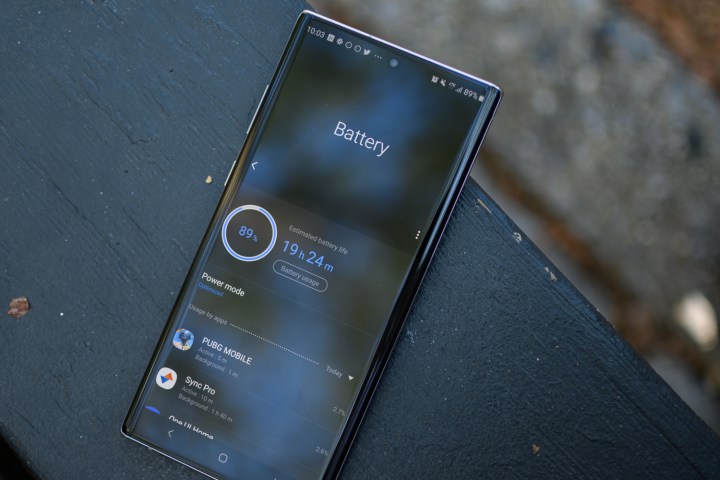
It’s great to have a large battery packed in a thin phone (7.9mm), but this is a common trend with the latest phones. Huawei put a 4,200mAh battery into the 7.57mm thin P30 Pro, and it has the best battery life we’ve seen. The Note 10 Plus hasn’t beaten it — in fact, the Note 10 Plus didn’t even beat the Galaxy S10 Plus in our video playback test. Playing a 1080p YouTube video with max brightness over Wi-Fi, the Note 10 Plus lasted for 12 hours and 30 minutes. The S10 Plus, with its 4,100mAh battery, lasted 10 minutes more. Meanwhile, the Huawei P30 Pro lasted 16 hours.
If you’re a heavy gamer, or if you use the camera a lot, you may want to pack a portable battery charger just in case. There are also many ways to lessen the drain on the battery, such as by lowering the screen resolution, or by turning on one of the various battery-saving modes.
Battery capacity is only a part of the story. Samsung phones are often slow to charge due to outdated fast charge technology. The Galaxy S10, for example, uses the Qualcomm Quick Charge 2.0 spec, which was announced in 2015. Competitors like LG have moved on to the Quick Charge 4+ standard.
Thankfully, the Galaxy Note 10 Plus charges faster, and comes with a 25-watt charger in the box. It still only supports Quick Charge 2.0 (it uses USB Power Delivery 3.0 instead), but with the 25-watt charger, there are tremendous improvements. In fact, in our battery charging speed test, the Note 10 Plus beat several popular competitors such as the OnePlus 7 Pro, taking just an hour and 2 minutes to recharge from zero percent (the OnePlus took 1 hour and 14 minutes). Compare that with the S10 Plus, which took 1 hour and 43 minutes, it’s easy to see the benefit — especially when you first plug it in as the Note 10 Plus already had 24 percent of juice in 10 minutes.

The Note 10 Plus can charge even quicker than that, but you need to buy a 45-watt charger that’s sold separately. With the 45-watt brick, the Samsung phone can juice up even faster at the beginning, which is handy if you only have a couple of minutes to charge before heading off. I haven’t tested this yet as we don’t have it, but I’ll add my thoughts here when I do. It’s likely not worth the extra $50, considering the speed of the included 25W charger. Apple, take note.
Wireless charging happens over Fast Wireless Charging 2.0, and it took the Note 10 Plus around 2 and a half hours to recharge fully using an Anker wireless charger (it might be faster if you use a Samsung charger, but not by much more). The Wireless Powershare feature makes a return from the S10 range, so you can top up other devices that support wireless charging like your friend’s iPhone XS or a pair of Galaxy Buds. The only other phones with this feature are from Huawei.
5G: The next-gen network
You can use 5G with Samsung’s latest Note phone, but you need to buy the Galaxy Note 10 Plus 5G. The standard Note 10 Plus only supports Wi-Fi 6 and LTE. It’s the same device, but the 5G variant is two grams heavier.
Samsung has announced a new feature called Play Galaxy Link that ties into the new 5G network. It lets you connect the Note 10 Plus 5G to your Windows PC and stream installed PC games to the phone, so you can play them anywhere in the world. Unlike Google’s upcoming Stadia service, the games are still powered by your computer. Details are light, such as streaming quality and whether it can access games from Steam, but it’s one feature of the Note 10 Plus I can’t wait to try out (it still works on all Note 10 models). It won’t be available on launch day and Samsung has not shared a timeline.
Price, availability, and warranty
The Samsung Galaxy Note 10 Plus is $1,100 and is available starting August 23. The standard Note 10 costs $950.
The Galaxy Note 10 Plus 5G costs $1,300 for the 256GB model and $1,400 for the 512GB version. It’s exclusive to Verizon first, but will make its way to the other carriers later. It shares the same availability details as the Note 10 and Note 10 Plus. If you’re on Verizon, check out our guide to the carrier’s 5G rollout to see if your city is on the list of 5G cities. You can check out all the deals and prices from various carriers on the Note 10 and Note 10 Plus here.
Samsung offers a standard limited warranty that covers manufacturer defects one year since the date of purchase. If you’re hoping for a discount, try looking at the best Samsung Galaxy deals and smartphone deals available now.
Our Take
The Note 10 Plus is an all-around winner. It can take excellent photos at various perspectives; its battery lasts about a full day, but its charging speed is among the fastest available on a phone; it has a beautifully-massive screen that looks futuristic; and all the speed you need for intensive tasks and gaming. It’s the renaissance man of phones.
Sure, it has a lot of gimmicky features — Samsung could trim the fat here — but it’s easy to ignore them. The S Pen still has its uses with solid note-taking capabilities and remains ideal for helping you snap photos.
Are there better alternatives?
There are a lot of excellent phones you can buy if you’re also considering the $1,100 Note 10 Plus — and all of them are a lot cheaper. The OnePlus 7 Pro, for example, has a stunning, immersive screen with a 90Hz refresh rate.
What about the iPhone? Apple’s iPhone 11 Pro Max is an excellent alternative for iOS fans, and probably the better pick if you’re on the fence. The iPhone has an even better camera, faster performance, and great battery life. Samsung’s screen is better, however, and Apple doesn’t offer stylus support on any iPhone. It could also be a toss-up between the Samsung Galaxy Note 20 Ultra and iPhone 11 Pro Max, regardless both are great options.
Check out our best smartphones guide for more.
How long will it last?
The Galaxy Note 10 Plus will last you more than three years. After that, you might begin to see shorter battery life due to battery degradation. Performance should remain acceptable for at least that long.
Samsung typically supports its phones through software updates for two years, so expect to get Android 10 and Android 11, but probably not Android 12.
Should you buy it?
Yes. The Note 10 Plus is an excellent Android smartphone that justifies its high price.
Editors' Recommendations
- Best Samsung Galaxy Z Fold 4 deals: Grab the foldable phone for $700
- Samsung has a new (and cheaper) way to buy the Galaxy S23
- Samsung Galaxy Ring: news, rumored price, release date, and more
- The 20 best Samsung Galaxy Watch faces you should be using
- A surprise phone just beat the Galaxy S24 Ultra in a big way

